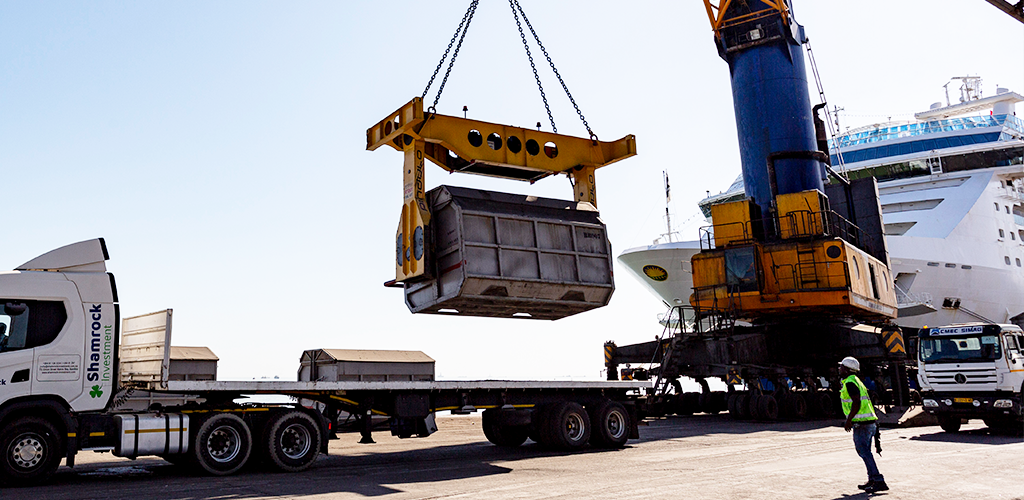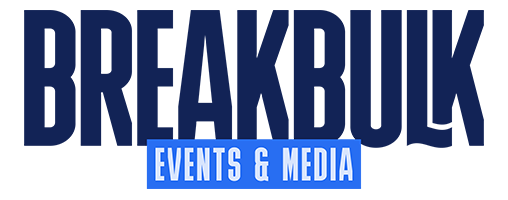Cargo Community Readies for Project Boom
By Liesl Venter

A frenzy has taken hold in the once-sleepy Namibian town of Walvis Bay on Africa’s southwest coast. Where shipments of fish, second-hand vehicles, copper and other routine raw minerals once dominated the local port, drilling pipes and oil exploration equipment now line the docks.
The country’s sudden success in the oil and gas sector is nothing short of extraordinary. For decades, intermittent offshore exploration yielded only a single discovery - the Kudu gas field, which holds contingent reserves of just 1.3 trillion cubic feet of gas.
Then, in January 2022, everything changed when Shell struck liquid gold with its Graff-1X discovery, which introduced the world to the untapped potential of the Orange Basin. Drilling at water depths of around 2,000 meters, Shell’s discovery of light oil turned global attention towards Namibia.
The discovery marked the beginning of a new era for the country. Just a month after Shell’s first find, TotalEnergies announced it had struck oil at the Venus-1X well, only for Shell to reveal another discovery at the La Rona-1 prospect in April. More discoveries were to follow for Shell at Jonker-1X and Lesedi-1X, solidifying Namibia’s offshore waters as a hotspot for exploration and investment.
While some expected momentum to slow down, the exact opposite has occurred. Earlier this year, Portuguese energy group Galp unveiled oil finds at Mopane-1X and Mopane-2X, with the field estimated to hold at least 10 billion barrels of oil.
Azule Energy, a joint venture between BP and Eni, has since joined the growing list of oil and gas players, having entered the market in May. In July, Chevron made headlines when it acquired a majority stake in an oil asset in the Walvis Basin region while also laying out plans to drill its first well in the prolific Orange Basin.
The finds have been massive. Shell’s Graff-1X discovery is estimated to hold around 200 million barrels of oil, while TotalEnergies’ Venus-1X could hold up to as much as 2 billion barrels of oil. Shell’s Jonker-1X find is said to contain an additional 300 million barrels. And the activity is not limited to offshore. ReconAfrica has started exploration onshore and is making progress in the drilling of the Naingopo well, which is targeting 181 million barrels of oil.
“Namibia has gone from struggling for years to make the Kudu gas fields viable to a situation where nearly every well drilled since 2022 has shown positive signs of hydrocarbons,” said African project expert Duncan Bonnett of analyst firm Africa House. “The actual oil reserves remain uncertain, but the opportunity is massive.
“The projects by Shell and TotalEnergies alone are estimated at investments of $12 billion to $13 billion respectively, with production potentially reaching 450,000 barrels per day as soon as 2027. This might very well be an ambitious timeline to start output, but the reality is that Namibia is truly on a roll, rewriting its energy narrative with each discovery.”
Rising Cargo Volumes
Although Namibia’s oil and gas sector is still young – the country has yet to pump a single barrel of oil - it hardly seems to matter, since industries across the board have experienced a surge in activity.
According to William Douni, senior trade manager at Breadbox Shipping Lines, while interest in Namibia has been steadily growing, there has been a significant surge in vessel calls to the country this year. Conducting an interview with Breakbulk, he noted that two ships were en route to Walvis Bay and Lüderitz ports. “We’ve completed at least seven shipments to Namibia this year, and it’s not over yet. We’re calling at Namibia far more frequently than ever before,” he said.
This sentiment is echoed by Martin Louw of MACS Walvis Bay and David Groves of MACS Houston, who both report increased activity. “There have been very positive developments in the country,” said Louw. “But the real excitement lies in what the next five to ten years hold when we will truly start seeing significant volumes moving to and from Namibia.”
According to Andrew Kanime, chief executive officer of Namport, there has been an uptick in breakbulk volumes, primarily driven by early- stage projects. “Namport processed around 5.6 million metric tons of breakbulk cargo last year. Our facilities have state-of-the-art infrastructure, including mobile cranes, reach stackers and designated storage areas,” he said, indicating the country could handle the current volumes.
“The Port of Walvis Bay features a specialized terminal for project cargo and breakbulk operations, with a draft of 12.8 meters and it has ample yard space to accommodate the volumes at present.”
According to Bonnett, the outlook for Namibia is promising. “It is not just oil and gas that holds potential. Mining has always been a Namibian stronghold and it has recently experienced a significant uptick. Namibia is one of the world’s largest uranium producers and while the sector has slowed down, there has been renewed investment in upgrading and refurbishing the uranium mines.
“Additionally, there is a lot of interest in new mining opportunities due to the demand for energy minerals such as copper, lithium and graphite. While the mines in Namibia may be smaller than those in the Democratic Republic of the Congo, they are still substantial.”
Bonnett also highlighted how the recent oil discoveries have brought gas into the spotlight. “The associated gas finds with the oil exploration finds could be the game-changer for the Kudu gas project, which has been in the pipeline for years, finally making it a large enough resource to justify its development.”
Renewable energy was another reason for the project sector to watch Namibia, he said. “The country is rapidly advancing with the Hyphen Hydrogen project, which has an investment volume of around $10 billion and is expected to produce 350,000 tons of green hydrogen annually. There are talks of producing and shipping approximately two million tons of ammonia annually by the end of this decade. There has also been an increase in wind and solar farms across the country.”
Limited Infrastructure
Kapil Grover, head of industrial projects for DHL Global Forwarding Middle East & Africa, emphasized the need to modernize and expand port infrastructure in Namibia to handle breakbulk and project cargo. “The limited infrastructure and capacity at the ports hinder the efficient capacity, including the expansion of storage facilities and investment in new handling equipment. We are also upgrading our terminals to better accommodate larger vessels and more complex cargo types.
“Improving our workforce training programs remains a priority to ensure our staff are well-prepared to handle the anticipated rise in breakbulk and project cargo.”
Establishing Footholds
Logistics companies are either entering or expanding their presence in Namibia as they position themselves to capitalize on the anticipated boom. With all the growth on the horizon, most firms are making strategic moves to establish a firm foothold ahead of the surge in activity, said Gerald Bryan Povey, director for Africa at Blue Water Shipping.
“We’ve done our homework and are confident about our expansion into the country. While it is all still in handling of large cargo, creating bottlenecks,” he told Breakbulk. This could significantly complicate logistics operations when the oil and gas projects take off particularly considering the size of some of the projects planned.
While Namibia is considered a relatively easy country to do business in, particularly within the African context, it still has complex regulatory frameworks and bureaucratic processes that often cause delays and increase costs. One such challenge is around visas, said Kevin Melnick, managing director of Pentagon Freight Southern Africa.
“Anyone who has visited the country more than three times a year cannot get a visa renewed. This can be a significant hurdle to overcome,” he reported. Grover added that local skills and the capabilities of local suppliers would also have to be improved to meet demand.
Melnick agreed that Namibian infrastructure needed attention. “The roads are taking strain considering the lack of rail availability. Currently equipment is sufficient to handle breakbulk and out-of-gauge cargo, but this will become a challenge as volumes increase. Warehousing and yard space outside of the ports must also be addressed.”
Most important, said Melnick, was investment and upgrades at the Port of Lüderitz. Louw reiterated this, saying a current limitation was that large projects could only be delivered into Walvis Bay, meaning goods must be trucked to Lüderitz, as rail solutions are often unreliable. “The Port of Lüderitz is limited to vessels with a length of less than 180 meters and an 8-meter draft,” Louws said. “There are plans to extend the current berth by an additional 500 meters, with completion targeted for 2026.”
Kanime acknowledged the infrastructure challenges and said Namport was actively working to address them. “We are implementing various initiatives to enhance our the exploration stage, the outlook is very positive. Projects have a long way to go, but we have no doubt that Namibia will explode,” he said.
According to Kirsten Beeker, the company’s general manager in Namibia, the demand for logistics service providers with oil and gas expertise has tripled in recent months. “We’re seeing a significant increase in charter vessels transporting oil and gas equipment. More so, there are no signs of activity slowing down - only intensifying.”
Povey’s outlook for Namibia is similar to the trajectory experienced in Guyana, another oil and gas hotspot. “We have high hopes for Namibia, especially given its potential to move swiftly from exploration to production. Much more development is on the horizon here and Namibia has all the elements for success.”
* BGSN Member
*Breakbulk Exhibitor
